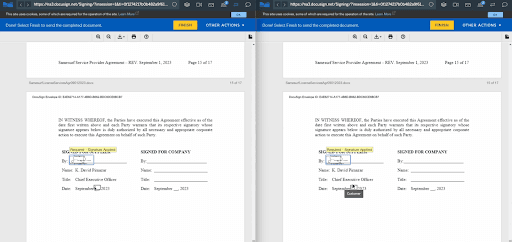Why Cloud Browser Cobrowse is Vastly Superior to Proxy-Based Cobrowse
November 12, 2025

Samesurf is the inventor of modern co-browsing and a pioneer in the development of core systems for Agentic AI.
The modern digital customer experience depends on real-time collaboration tools with co-browsing now essential for driving customer satisfaction, improving conversion rates, and enhancing key efficiency metrics such as First Contact Resolution and Average Handle Time. However, the underlying architecture that enables this form of collaboration often determines the balance between innovation and risk. For enterprises in highly regulated industries such as Finance and Healthcare, aligning seamless CX with non-negotiable compliance mandates such as GDPR, HIPAA, and PCI DSS, is both a technical and strategic imperative.
A clear architectural divide defines the future of co-browsing. Legacy systems, known as Proxy-Required Co-Browsing, depend on network interception and Document Object Model synchronization to replicate the browsing session. This method creates persistent security vulnerabilities, as data masking within the DOM is inherently fragile and requires constant manual intervention to maintain compliance. The result is an unsustainable security posture that accumulates technical debt over time.
The secure and scalable alternative is the Cloud Browser architecture, exemplified by Samesurf. Instead of relying on interception, this model achieves security through isolation. Each collaboration session operates within an isolated browser instance in the cloud and is completely separated from the user’s device and local network. This server-side rendering approach enables enterprise-grade safeguards such as sandboxed environments, automated content-level redaction, and zero data retention policies.
For organizations under strict regulatory oversight, transitioning from interception-based frameworks to architecturally isolated environments is no longer optional; it’s foundational. The Cloud Browser model not only eliminates the inherent risks of legacy systems but also establishes a secure, compliant, and future-ready framework for real-time collaboration and customer engagement.
Deconstructing the Legacy Model: Proxy-Required Co-browsing
Proxy-based co-browsing operates as a man-in-the-middle intermediary that intercepts web traffic between the user and the destination website. The system reconstructs webpage code such as HTML, CSS, and JavaScript in real time within a shared environment visible to both the customer and the agent.
Synchronization occurs through the transmission of real-time updates to the page’s underlying structure, known as Document Object Model events. Often promoted as a “zero-integration” or “codeless” solution, this method functions without pre-installed code on the target site. However, the convenience of quick deployment conceals serious architectural weaknesses that accumulate as ongoing security debts.
1. Fragile Data Masking and Compliance Instability
DOM-based systems depend on masking rules linked to specific structural elements within a webpage. These rules identify sensitive fields based on their location or identifiers in the DOM. Even minor updates to a website’s code can disrupt masking integrity. As websites evolve frequently in agile development environments, previously hidden fields can become visible to agents and expose Protected Health Information, Personally Identifiable Information, or payment data.
Maintaining compliance with standards such as HIPAA and GDPR requires constant developer intervention. Each website change introduces a new potential failure point, which results in a cycle of patching, monitoring, and revalidation that consumes resources and weakens data protection.
2. Risk Amplification Through Data Logging
Proxy servers process and often retain logs of all traffic passing through them, including metadata such as URLs, authentication tokens, and session activity. Without strict encryption, access control, and retention policies, these logs represent a high-value target for attackers.
A compromise of this intermediary layer could expose credentials, internal browsing activity, and sensitive customer data. Rather than serving as a security buffer, the proxy becomes a single point of failure that expands the organization’s risk profile.
3. Performance Overhead and Latency
The interception, decryption, and real-time reconstruction processes in proxy-based architectures introduce latency and degrade performance. Increased lag slows the agent’s response time and negatively affects the customer experience, thereby undermining the purpose of real-time collaboration.
The Secure Foundation: Cloud Browser Co-browsing Architecture
Secure co-browsing is critical for modern enterprises, particularly in regulated industries. The architecture behind the collaboration platform determines the level of security, compliance, and operational reliability. Samesurf’s cloud-based approach establishes a robust foundation that minimizes risk, enforces governance, and protects sensitive data while enabling seamless collaboration. The following principles illustrate how this architecture achieves security and compliance at scale.
1. The Principle of Isolation and Dedicated Cloud Instances
Secure co-browsing relies on complete architectural isolation for all connected AI agent and/or human devices. All devices connect to a dedicated, cloud-hosted browser instance that is fully isolated from the end-user device and enterprise network.
2. Server-Side Sandboxing and the Digital Air Gap
Samesurf’s advanced cloud browser platform employs server-side sandboxing to relocate the browsing environment away from both the host device and enterprise network. This approach minimizes the attack surface and protects against malware or rogue scripts that could target local systems.
Server-side sandboxing establishes a digital air gap that physically and virtually separates collaborative sessions from enterprise networks and user devices. The sandbox enforces strict resource limits and provides an instant “kill switch” to terminate the session immediately if malicious or unexpected behavior is detected. This controlled environment delivers the security and compliance assurance that is required for sensitive enterprise applications, including Agentic AI deployments.
3. Strict Data Minimization and Zero Retention Policy
Cloud browser architecture adheres to strict data minimization principles. Samesurf’s platform ensures that no session data is stored, written to disk, or retained beyond the active interaction. All session data is purged immediately at the conclusion of the session.
Zero Data Retention provides a superior compliance strategy that eliminates the largest source of data liability. By retaining no high-value session data, organizations reduce the scope of audits and ensure alignment with regulatory requirements such as GDPR. Security responsibilities are shifted to protecting data in transit and controlling access during the ephemeral session, effectively eliminating the risk of data exposure at rest.
Compliance, Control, and Risk Mitigation in Highly Regulated Environments
Highly regulated industries cannot tolerate architectural compromises that jeopardize data security. Compliance requirements demand sophisticated protection measures, including Dynamic Data Masking and, in certain cases, the irreversible pseudonymization or transformation of sensitive fields.
- HIPAA and PHI: Healthcare organizations must ensure that Protected Health Information is de-identified and handled within a fully controlled environment. Cloud browser solutions must provide HIPAA-compliant capabilities to securely support sensitive tasks such as onboarding patients to digital tools, guiding them through complex forms, and processing insurance claims.
- PCI DSS: Organizations handling payment data must comply with the Payment Card Industry Data Security Standard, which mandates strict masking of the full Primary Account Number, typically allowing only the first six and last four digits to be visible to authorized roles. Maintaining this standard is exceptionally challenging with legacy systems due to reliability and volatility issues.
The critical security distinction lies in where and how data masking is applied. Proxy-based solutions rely on client-side code that is prone to failure, whereas secure cloud solutions implement data masking, Element Redaction, and Input Field Blocking at the server level.
Sensitive elements are identified and masked before the session stream reaches the AI and/or human agent to ensure that all non-authorized devices never visually access bank account details, social security numbers, or login credentials. Server-side Element Redaction provides robust, consistent protection because it does not depend on the volatile structure of the client-side Document Object Model. This approach eliminates the operational risks and high-maintenance requirements associated with proxy-based masking, ultimately transforming security from a potential liability into a controlled assurance framework. Organizations benefit from reduced exposure to regulatory penalties and enhanced compliance confidence.
Secure co-browsing also strengthens customer trust by giving users control over the interaction from the start in situations where a human device is involved. Sessions typically require customers to provide an Account-Level PIN to the agent, which establishes verified authority.
To further protect organizations and ensure customer control, secure platforms restrict agent actions through features such as Button Blocking. This prevents agents from submitting forms or initiating irreversible actions, including purchases or agreements, on the customer’s behalf. The customer retains final executive control over all sensitive transactions, thereby ensuring transparency, accountability, and trust throughout the interaction.
Samesurf and the Benchmarks of Modern Co-browsing
In providing a parallel, legacy co-browsing solutions often require complex installations, custom coding, and precise placement of code snippets. This dependency on internal web development teams can delay deployment for months, particularly when teams are already managing full workloads.
Samesurf’s cloud-based platform fundamentally changed this deployment model. The platform offers a fully codeless experience that allows instant implementation without installation or code placement. This zero-friction approach accelerates adoption and reduces reliance on IT resources. Organizations can start with the codeless deployment and later add a single line of code to enable a fully integrated, on-site experience.
The streaming architecture of cloud browsers delivers clear advantages in performance and user experience over legacy DOM-rebuilding methods. User devices are able to experience lightning-fast response times with high-fidelity graphics and audio, which eliminates the latency and visual inconsistencies common to older co-browsing tools. Fully synchronized video sharing further enhances collaborative interactions to ensure a seamless customer journey.
Legacy DOM-dependent solutions also impose significant scope limitations, often restricting co-browsing to the company website where the code is embedded or proxy rules apply. Modern cloud browsers overcome this constraint by supporting all types of content and enabling co-browsing of external sites not operated by the client.
The ability to co-browse external domains is critical for end-to-end digital support. Customer workflows, such as loan applications or e-commerce checkouts, frequently involve third-party portals, payment gateways, or government sites. If a co-browsing tool loses synchronization when the customer device navigates to these external platforms, the agent device loses visibility which forces reliance on less secure methods like screen sharing or risking workflow disruption. Samesurf’s cloud browser platform maintains full synchronization across all domains by rendering content in a secure, isolated cloud environment, independent of client-side code. This capability drives measurable improvements in key operational metrics such as First Contact Resolution and customer conversion which also have a profound impact on the effective operation of Samesurf’s Agentic AI platform.
Conclusion and Strategic Recommendations
For enterprise leadership, the selection of a particular architecture is fundamentally a decision concerning risk management and long-term security debt. Legacy proxy-required models may offer the perceived benefit of quick, codeless deployment; however, this comes at the cost of systemic, unquantifiable compliance risk stemming from fragile, DOM-dependent data masking and the serious liability of handling authentication tokens and sensitive metadata.
Samesurf’s Cloud Browser architecture transforms both Agentic AI and co-browsing operations from a potential liability into a high-assurance, secure component of the digital stack. By achieving architectural and virtual isolation through server-side sandboxing, the platform creates a digital air gap that mitigates the risk of compromise to the host device or the enterprise network. When coupled with a strict zero-data-retention policy, this approach directly addresses and eliminates the primary security exposures inherent in data privacy regulations.
Technology leaders tasked with deploying CX and Agentic AI tools should follow a strict set of architectural criteria to ensure regulatory compliance and maximize strategic benefit:
- Prioritize Isolation Over Interception: Reject any solution that relies on forcing customer traffic through an intermediary proxy server or that connects directly to the end-user device. Mandate a secure cloud architecture that utilizes server-side sandboxing to ensure that the session execution environment is isolated and instantly terminable.
- Mandate Zero Retention: Critically verify, through architectural review, that the vendor implements a zero-data-retention policy for sensitive session data. This strategic choice eliminates the substantial liability tied to the long-term storage and management of PII/PHI under GDPR and similar regulations.
- Audit Masking Reliability: Demand proof that data masking is implemented architecturally and not reliant on volatile, client-side Document Object Model analysis or constant engineering updates. Masking must be robust enough to withstand dynamic website changes without human intervention.
- Evaluate Strategic Scope: Select a solution that offers universal content compatibility. The capability to access all content types, including external, non-client-operated sites, is essential for truly supporting the full, complex customer journey and achieving maximum impact on FCR and conversion rates.
For enterprises seeking secure, compliant, and scalable systems for both Agentic AI and co-browsing, Samesurf provides the proven architecture to deliver both operational efficiency and regulatory assurance. By choosing Samesurf, organizations can transform their digital initiatives into a strategic advantage rather than a liability.
Visit samesurf.com to learn more or go to https://www.samesurf.com/request-demo to request a demo today.


